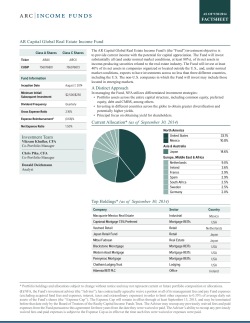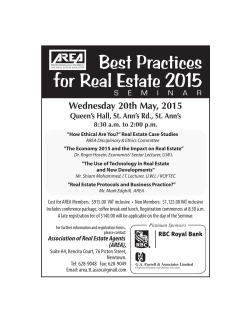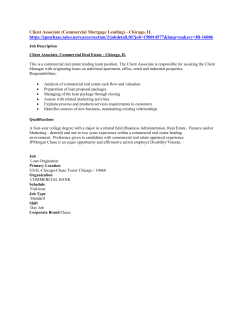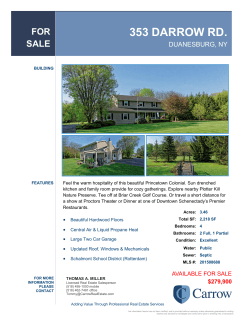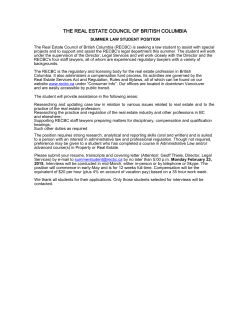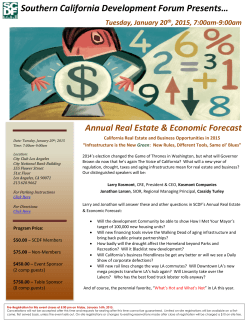
Real Estate Fund
SUMMARY PROSPECTUS TRREX May 1, 2015 T. Rowe Price Real Estate Fund A stock fund seeking capital appreciation and income through investments in companies involved in the real estate industry. Before you invest, you may want to review the fund’s prospectus, which contains more information about the fund and its risks. You can find the fund’s prospectus and other information about the fund online at troweprice.com/prospectus. You can also get this information at no cost by calling 1-800-225-5132 or by sending an e-mail request to info@troweprice.com. This Summary Prospectus incorporates by reference the fund’s prospectus, dated May 1, 2015, and Statement of Additional Information, dated May 1, 2015. The Securities and Exchange Commission has not approved or disapproved these securities or passed upon the adequacy of this prospectus. Any representation to the contrary is a criminal offense. S UMMARY 1 Investment Objective The fund seeks to provide long-term growth through a combination of capital appreciation and current income. Fees and Expenses This table describes the fees and expenses that you may pay if you buy and hold shares of the fund. Fees and Expenses of the Fund Shareholder fees (fees paid directly from your investment) Maximum sales charge (load) imposed on purchases NONE Maximum deferred sales charge (load) NONE Redemption fee (as a percentage of amount redeemed on shares held for 90 days or less) 1.00% $20 Maximum account fee a Annual fund operating expenses (expenses that you pay each year as a percentage of the value of your investment) Management fees 0.59% Distribution and service (12b-1) fees 0.00% Other expenses 0.17% Total annual fund operating expenses 0.76% a Subject to certain exceptions, accounts with a balance of less than $10,000 are charged an annual $20 fee. Example This example is intended to help you compare the cost of investing in the fund with the cost of investing in other mutual funds. The example assumes that you invest $10,000 in the fund for the time periods indicated and then redeem all of your shares at the end of those periods. The example also assumes that your investment has a 5% return each year and that the fund’s operating expenses remain the same. Although your actual costs may be higher or lower, based on these assumptions your costs would be: 1 year $78 3 years $243 5 years $422 10 years $942 Portfolio Turnover The fund pays transaction costs, such as commissions, when it buys and sells securities (or “turns over” its portfolio). A higher portfolio turnover rate may indicate higher transaction costs and may result in higher taxes when fund shares are held in a taxable account. These costs, which are not reflected in annual fund operating expenses or in the example, affect the fund’s performance. During the most recent fiscal year, the fund’s portfolio turnover rate was 3.3% of the average value of its portfolio. T. R OWE P RICE 2 Investments, Risks, and Performance Principal Investment Strategies The fund will normally invest at least 80% of its net assets (including any borrowings for investment purposes) in the equity securities of real estate companies. The fund’s definition of real estate companies is broad and includes those companies that derive at least 50% of their revenues or profits from, or commit at least 50% of assets to, real estate activities. The fund is likely to maintain a significant portion of assets in real estate investment trusts (REITs). REITs pool money to invest in properties (equity REITs) or mortgages (mortgage REITs). The fund generally invests in equity REITs. The fund defines the real estate industry broadly. It includes (but is not limited to) the following: • • • • • • • REITs; real estate operating companies; brokers, developers, and builders of residential, commercial, and industrial properties; property management firms; finance, mortgage, and mortgage servicing firms; construction supply and equipment manufacturing companies; and firms dependent on real estate holdings for revenues and profits, including lodging, leisure, timber, mining, and agriculture companies. The fund will not own real estate directly and will have no restrictions on the size of companies selected for investment. Up to 20% of fund assets may be invested in companies deriving a substantial portion of revenues or profits from servicing real estate firms, as well as in companies unrelated to the real estate business. Stock selection is based on fundamental, bottom-up analysis that generally seeks to identify high-quality companies with both good appreciation prospects and incomeproducing potential. Factors considered by the portfolio manager in selecting real estate companies include one or more of the following: relative valuation; free cash flow; undervalued assets; quality and experience of management; type of real estate owned; and the nature of a company’s real estate activities. In pursuing its investment objective, the fund has the discretion to deviate from its normal investment criteria. These situations might arise when the fund’s management believes a security could increase in value for a variety of reasons, including an extraordinary corporate event, a new product introduction or innovation, a favorable competitive development, or a change in management. While most assets will typically be invested in U.S. common stocks, including REITs, the fund may also invest in foreign stocks in keeping with the fund’s objectives. The fund may sell securities for a variety of reasons, such as to secure gains, limit losses, or redeploy assets into more promising opportunities. Principal Risks As with any mutual fund, there is no guarantee that the fund will achieve its objective. The fund’s share price fluctuates, which means you could lose S UMMARY 3 money by investing in the fund. The principal risks of investing in this fund are summarized as follows: Active management risk The fund is subject to the risk that the investment adviser’s judgments about the attractiveness, value, or potential appreciation of the fund’s investments may prove to be incorrect. If the securities selected and strategies employed by the fund fail to produce the intended results, the fund could underperform other funds with similar objectives and investment strategies. Risks of stock investing Stocks generally fluctuate in value more than bonds and may decline significantly over short time periods. There is a chance that stock prices overall will decline because stock markets tend to move in cycles, with periods of rising and falling prices. The value of a stock in which the fund invests may decline due to general weakness in the stock market or because of factors that affect a particular company or industry. Industry risk A fund that focuses its investments in specific industries or sectors is more susceptible to developments affecting those industries and sectors than a more broadly diversified fund. Because the fund invests significantly in real estate companies, the fund may perform poorly during a downturn in the real estate industry. Real estate companies can be adversely affected by, among other things, general and local economic conditions, interest rates, changes in zoning or tax laws or other government regulations, overbuilding, and demographic trends such as population shifts. REIT investing risk REITs must satisfy specific requirements for favorable tax treatment and can involve unique risks in addition to the risks generally affecting the real estate industry. REITs are dependent upon the quality of their management, may have limited financial resources and heavy cash flow dependency, and may not be diversified geographically or by property type. Foreign investing risk This is the risk that the fund’s investments in foreign securities may be adversely affected by political, social, and economic conditions overseas, greater volatility, reduced liquidity, or decreases in foreign currency values relative to the U.S. dollar. Performance The bar chart showing calendar year returns and the average annual total returns table indicate risk by illustrating how much returns can differ from one year to the next and how fund performance compares with that of a comparable market index. The fund’s past performance (before and after taxes) is not necessarily an indication of future performance. The fund can also experience short-term performance swings, as shown by the best and worst calendar quarter returns during the years depicted. T. R OWE P RICE 4 In addition, the average annual total returns table shows hypothetical after-tax returns to suggest how taxes paid by a shareholder may influence returns. After-tax returns are calculated using the historical highest individual federal marginal income tax rates and do not reflect the impact of state and local taxes. Actual after-tax returns depend on an investor’s tax situation and may differ from those shown. After-tax returns shown are not relevant to investors who hold their fund shares through taxdeferred arrangements, such as a 401(k) account or individual retirement account. In some cases, the figure shown under “returns after taxes on distributions and sale of fund shares” may be higher than the figure shown under “returns before taxes” because the calculations assume the investor received a tax deduction for any loss incurred on the sale of shares. Average Annual Total Returns Periods ended December 31, 2014 1 Year 5 Years 10 Years Real Estate Fund Returns before taxes 29.75 % 16.93 % 8.35 % Returns after taxes on distributions 28.43 16.13 7.29 Returns after taxes on distributions and sale of fund shares 16.81 13.31 6.31 Wilshire US Real Estate Securities Index (reflects no deduction for fees, expenses, or taxes) 31.53 17.23 8.15 Lipper Real Estate Funds Index 27.78 16.03 8.29 S UMMARY 5 Updated performance information is available through troweprice.com or may be obtained by calling 1-800-225-5132. Management Investment Adviser T. Rowe Price Associates, Inc. (T. Rowe Price) Portfolio Manager David M. Lee Title Chairman of Investment Advisory Committee Managed Joined Investment Fund Since Adviser 1997 1993 Purchase and Sale of Fund Shares The fund requires a $1,000 minimum initial investment, and a $100 minimum subsequent investment, for individual retirement accounts, small business retirement plan accounts, and Uniform Gifts to Minors Act or Uniform Transfers to Minors Act accounts. For all other accounts, the fund generally requires a $2,500 minimum initial investment and a $100 minimum subsequent investment. The investment minimums may be modified for financial intermediaries that submit orders on behalf of their customers. You may purchase, redeem, or exchange fund shares by accessing your account online at troweprice.com, by calling 1-800-225-5132, or by written request. If you hold shares through a financial intermediary, you must purchase, redeem, and exchange shares through your intermediary. Tax Information Any dividends are declared and paid quarterly in March, June, September, and December. Any capital gains are declared and paid annually, usually in December. Redemptions or exchanges of fund shares and distributions by the fund, whether or not you reinvest these amounts in additional fund shares, may be taxed as ordinary income or capital gains unless you invest through a tax-deferred account (although you may be taxed upon withdrawal from such account). Payments to Broker-Dealers and Other Financial Intermediaries If you purchase shares of the fund through a broker-dealer or other financial intermediary (such as a bank), the fund and its related companies may pay the intermediary for the sale of fund shares and related services. These payments may create a conflict of interest by influencing the broker-dealer or other intermediary and your salesperson to recommend the fund over another investment. Ask your salesperson or visit your financial intermediary’s website for more information. T. Rowe Price Associates, Inc. 100 East Pratt Street Baltimore, MD 21202 F122-045 5/1/15
© Copyright 2025
